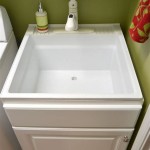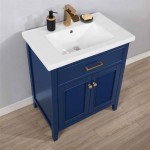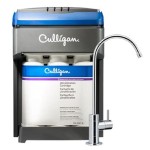Small Bathroom Vanities With Vessel Sinks: A Stylish and Functional Solution
The challenge of maximizing space in a small bathroom is a common one for homeowners and designers alike. Balancing functionality with aesthetic appeal requires careful consideration of each element. Small bathroom vanities paired with vessel sinks have emerged as a particularly effective solution for addressing both spatial constraints and design aspirations. This article will explore the advantages, considerations, and practical aspects of incorporating small bathroom vanities with vessel sinks into a limited bathroom space.
Vessel sinks, also known as above-counter sinks, sit atop the vanity rather than being recessed into it. This design characteristic offers several benefits. First, it frees up valuable storage space underneath the vanity. Since the plumbing connections are typically lower than with traditional sinks, more of the cabinet's internal volume can be utilized for shelving or drawers. Second, vessel sinks often provide an opportunity to introduce a unique design element. Available in a wide array of materials, shapes, and colors, they can serve as a focal point in the bathroom, adding a touch of personality and style. Finally, their raised profile can be ergonomically advantageous for some users, potentially reducing strain during washing.
Maximizing Space and Storage
In a small bathroom, every square inch counts. Standard recessed sinks require a certain amount of vanity depth to accommodate the bowl and plumbing. Small bathroom vanities with vessel sinks circumvent this requirement. Because the bowl sits on top, the vanity itself can be shallower, thereby freeing up floor space. This is particularly beneficial in narrow or awkwardly shaped bathrooms where maneuverability is limited.
Furthermore, the internal configuration of the vanity can be optimized for storage. Without the encumbrance of a traditional sink bowl, drawers can be full-width and deeper. Shelves can be positioned more strategically to accommodate toiletries, cleaning supplies, and other bathroom essentials. Some vanities are even designed with open shelving, creating an airy feel and providing easy access to frequently used items.
Wall-mounted vanities, especially when paired with vessel sinks, further enhance the sense of spaciousness. By suspending the vanity off the floor, more of the floor area is visible, making the bathroom feel larger than it actually is. This also simplifies cleaning, as there are no awkward corners or gaps where dirt and grime can accumulate.
The choice of vanity material also plays a role in maximizing perceived space. Light-colored vanities, such as white, beige, or light gray, tend to reflect more light, making the bathroom feel brighter and more open. Opting for vanities with reflective surfaces, such as mirrored doors or glossy finishes, can further amplify this effect.
Design Considerations and Style Options
The aesthetic possibilities of small bathroom vanities with vessel sinks are virtually limitless. Vessel sinks are available in a broad spectrum of materials, including ceramic, glass, stone, metal, and even wood. Each material offers a distinct look and feel, allowing homeowners to tailor the bathroom's design to their specific preferences.
Ceramic vessel sinks are a popular choice due to their durability, ease of cleaning, and versatility. They can be found in a wide range of shapes, from simple round bowls to more elaborate geometric designs. Glass vessel sinks offer a sleek and modern aesthetic, adding a touch of elegance to the bathroom. Stone vessel sinks, such as those made from granite or marble, exude a sense of luxury and sophistication. Metal vessel sinks, often crafted from copper or stainless steel, lend a contemporary and industrial vibe.
The shape of the vessel sink can also significantly impact the overall design. Round or oval sinks create a softer, more organic feel, while square or rectangular sinks offer a more structured and modern look. The height of the sink can also influence the bathroom's ergonomics. A taller sink may be more comfortable for taller individuals, while a shorter sink may be more suitable for children or those with mobility issues.
The vanity itself should complement the vessel sink's style. A rustic wooden vanity pairs well with a stone vessel sink, creating a warm and inviting ambiance. A sleek, minimalist vanity with clean lines complements a glass vessel sink, enhancing the bathroom's modern appeal. The choice of hardware, such as faucets and cabinet pulls, should also be carefully considered to ensure a cohesive and harmonious design.
Lighting is another crucial element to consider. Proper lighting can accentuate the vessel sink's unique features and create a welcoming atmosphere. Under-cabinet lighting can highlight the vanity's design and provide ambient illumination. A well-placed vanity light above the sink can provide task lighting for grooming and other activities.
Practical Considerations and Installation
While small bathroom vanities with vessel sinks offer numerous advantages, there are also several practical considerations to keep in mind. The first is the faucet selection. Because the vessel sink sits above the counter, a taller faucet or a wall-mounted faucet is typically required to reach the sink. The faucet's style should complement the sink and vanity's design, and its functionality should be carefully evaluated.
The sink's drainage should also be considered. Vessel sinks typically require a pop-up drain or a grid drain. A pop-up drain allows the user to easily open and close the drain, while a grid drain provides a more decorative and minimalist look. The drain's finish should match the faucet's finish for a cohesive look.
The installation process for a small bathroom vanity with a vessel sink is generally straightforward, but it is important to follow the manufacturer's instructions carefully. The vanity should be securely mounted to the wall or floor, and the plumbing connections should be properly sealed to prevent leaks. If unsure about any aspect of the installation, consulting a professional plumber is recommended.
Maintenance is also an important consideration. Vessel sinks, particularly those made from glass or stone, may require more frequent cleaning than traditional sinks. Using a gentle, non-abrasive cleaner is recommended to avoid scratching or damaging the surface. Regular cleaning will help to keep the sink looking its best and prevent the buildup of soap scum or other deposits.
Consider the height of the countertop in relation to the vessel sink. The combined height should be comfortable for the user. If the countertop is too low, it can cause strain on the back. If the countertop is too high, it can make washing hands uncomfortable. Measure the height of existing countertops and sinks to get a sense of what works best.
The material of the vanity countertop should also be carefully selected. Common choices include granite, quartz, marble, and solid surface materials. Granite and quartz are durable and resistant to stains and scratches, making them a good choice for high-traffic bathrooms. Marble is a luxurious option, but it is more porous and requires more maintenance. Solid surface materials are non-porous and easy to clean, but they may not be as durable as natural stone.
When choosing a vanity size, consider the overall dimensions of the bathroom and the available space. Measure the width, depth, and height of the space to ensure that the vanity will fit comfortably. Leave enough space around the vanity for comfortable movement and access to other bathroom fixtures.
Think about the overall style of the bathroom when selecting a vanity and vessel sink. The vanity should complement the other elements in the bathroom, such as the tiles, flooring, and fixtures. Choose a style that reflects your personality and creates a cohesive and inviting space.
Consider the weight of the vessel sink and the vanity's ability to support it. Stone and metal vessel sinks can be quite heavy, so it is important to choose a vanity that is strong enough to bear the weight. Check the manufacturer's specifications to ensure that the vanity can safely support the chosen vessel sink.
Think about the lighting around the vanity. Adequate lighting is essential for grooming and other activities. Consider adding task lighting above the vanity or under-cabinet lighting to provide extra illumination. Choose light fixtures that complement the style of the vanity and vessel sink.
Remember to factor in the cost of installation when budgeting for a small bathroom vanity with a vessel sink. Installation costs can vary depending on the complexity of the project and the plumber's rates. Get quotes from several different plumbers to ensure that you are getting a fair price.
Ensuring Ergonomics and Accessibility
Beyond aesthetics and space-saving benefits, ergonomics and accessibility are pivotal factors in selecting a small bathroom vanity with a vessel sink. The height of the vanity and sink combination should be comfortable for all users, especially those with mobility limitations. A vanity that is too low can cause back strain, while one that is too high can make it difficult to reach the faucet and sink.
Wall-mounted vanities, as mentioned previously, offer added flexibility in adjusting the height to suit individual needs. The open space beneath the vanity also provides ample room for wheelchair users to maneuver. When selecting hardware, opt for lever-style faucets and easy-to-grip cabinet pulls to make them accessible for people with limited dexterity.
Consider the placement of the vanity in relation to other bathroom fixtures. Ensure that there is sufficient clearance around the vanity for comfortable movement. Avoid placing the vanity in a location that obstructs doorways or makes it difficult to access the toilet or shower.
Pay attention to the placement of electrical outlets. Position outlets within easy reach of the vanity for convenient use of hairdryers, electric razors, and other personal care appliances. Ensure that the outlets are GFCI-protected to prevent electrical shock.
Ultimately, the best small bathroom vanity with a vessel sink is one that seamlessly blends style, functionality, and ergonomics. By carefully considering the various factors discussed in this article, homeowners can create a bathroom that is both visually appealing and practical for their specific needs.

Top 20 Bathroom Vanities With Vessel Sinks Ideas For 2024 Badeloft

Stylish And Diverse Vessel Bathroom Sinks Decoist Small Vanities Farmhouse Vanity

Live Edge Vanity For Basin Sink Or Wall Mounted Floating Etsy Singapore
;?strip=all)
Bathroom Transformations Trends Stylish Vessel Sinks Granite Blog

Are Vessel Sinks Still In Style The Lived Look

Vessel Sinks A Complete Guide Roomhints

Contemporary Powder Room Features A Glass Mirror Placed Over Floating Vanity Topped With Small Bathroom Sinks Remodel Bathrooms

22 25 Amanda Single Vessel Sink Vanity Bathgems Com

Pros Cons Of A Vessel Sink

36 Espresso Modern Bathroom Vanity Vessel Single Sink With Faucet And Linen Side Cabinet Option







